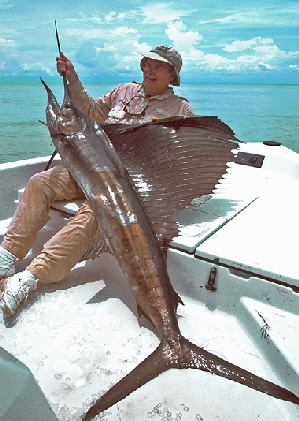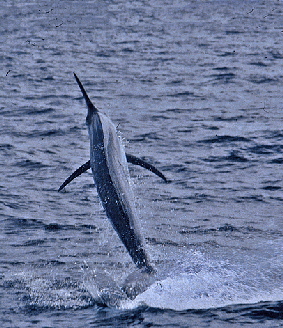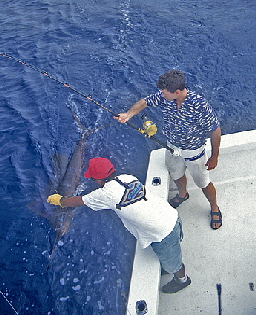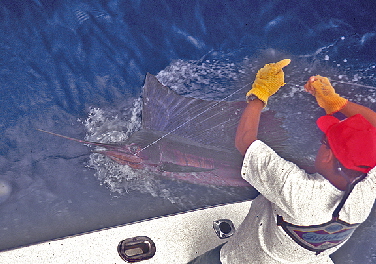"Let's move to the other side of the Gulf," said Captain Jon West. "The roosters may be hitting over there."
He put his 21-foot Champion boat on a plane and we headed across the mouth of Costa Rica's
southernmost gulf toward the Osa Peninsula. We were scooting through 2 to 3 foot seas when West
pointed out the blue-water rip in front of us. Pacific Sails sometimes come into the 30-mile long gulf with
the rips as they are pushed inshore and into the "sweet" waters. West and I were both admiring the pretty blue water when we motored right by a large gray shape near the surface.
"What was that," I queried the captain. "It looked like a sailfish to me."
 "Get your bait ready," he shouted as he quickly turned the boat and motored toward the spot where the fish was seen. "It was a sail." "Get your bait ready," he shouted as he quickly turned the boat and motored toward the spot where the fish was seen. "It was a sail."
We grabbed the two rigged outfits and cast them 40 to 50 yards out. A lightweight 7-foot bass rod and Calcutta 400
reel spooled with 15-pound test Triple Fish monofilament was baited with a sardine, while a heavier outfit with 25-pound test on a two-speed conventional reel was baited with a
hand-size blue runner. We readied for action and we were not disappointed.
It was my luck that the sail blew up on the hapless sardine
on the terminal end of the lighter-weight outfit. I slowly set back on the rod as the circle hook found its mark, and then held on. The sailfish exploded again on the surface, and
swirled beside the second bait.
Seconds later, the big sailfish jumped twice again and the
line on the second, heavier outfit separated from the first. The fish had not been hooked, so the captain cleared the line, as my battle continued with the sail, sky jumping all
over the gulf. Then it streaked away and peeled line from my relatively small baitcaster. West put the boat in gear to follow. The fish that West estimated to be over 125 pounds
unceremoniously stripped off any line that I was able to retrieve back onto the spool. The captain kept our small boat near the action by bumping the outboard into and out of gear as warranted.
I had regained much of my line when the fish went skyward near the boat several times, and I hung on. I
was drenched from the workout but optimistic about my chances of landing the fish. Slowly, I fought the
fish closer to the boat, but it simply swam along about 10 feet down out of reach of our 3-foot leader. I
was leery of trying to force it to the surface with 15-pound test line, and I could not turn its head easily.
The sail tried a couple more have-hearted leaps with half of its massive body breaching the surface just 20
feet out. That was 30 minutes into the action. The following 30 minutes was a game of pulling the tired
sail to the gunwale where it remained 6 to 8 feet deep, and then watching it gain a little strength and swim off very slowly again moving near the surface. The fish was tired. I was tired.
 Finally, I worked the slow-swimming sailfish near the boat, and it remained near the surface where West had a chance to grab
it. The burly captain got a firm grasp on its bill and used most of his muscles to horse it into our 21-foot boat for a few quick
photos. The sail knocked over our drink cooler then calmed down for the brief photo session. West placed the fish back over the side, and we measured it at 105 1/2 inches long.
With the aid of our motor, we pulled the fish boatside short distance until it fully recovered and swam off. Finally, I worked the slow-swimming sailfish near the boat, and it remained near the surface where West had a chance to grab
it. The burly captain got a firm grasp on its bill and used most of his muscles to horse it into our 21-foot boat for a few quick
photos. The sail knocked over our drink cooler then calmed down for the brief photo session. West placed the fish back over the side, and we measured it at 105 1/2 inches long.
With the aid of our motor, we pulled the fish boatside short distance until it fully recovered and swam off.
The captain's revised estimate was 130 pounds and the fish was the first large sailfish taken on 15-pound test from his
small Crocodile Bay skiff. The beautiful fish was one of the largest taken in Golfo Dulce ever on any tackle. I was beat from battling the monster on bass tackle, and we were both
elated! What a great ending to the trip!
One of the most unique aspects of Crocodile Bay Lodge is that they offer both inshore and offshore fishing from a variety of
boats most suitable for the action. In fact, their fishing packages are usually based on a combination of activities.
You board a 27-foot Rambo inboard or the 32-foot Strike and go offshore for a day or two of billfishing or
for wahoo, tuna or dolphin action, and then hop aboard a 17-foot Back Country flats skiff for a try in the
mangrove estuaries and rivers for snook, snapper, and corvina. Then, take one of the 21-foot Champion
Bay Runner boats into the Golfo Dulce for roosterfish, Pacific jack, snapper and grouper or mackerel.
The following two days consisted of inshore action in the gulf and just outside it along the mountainous
Pacific coast near Panama. I caught and released a couple hard-hitting roosterfish along the rocky drop
-off stretches south of the gulf's mouth, along with a 10-pound "pargo" or red snapper. The jungle scenery
was outstanding with mountain rockslides, clear-cut areas at Indian encampments, and craggy islands along a volcanic coastline.
 Other anglers there have taken blue marlin up to 650 pounds, 20 sailfish in a day, dolphin up to 50 pounds, roosterfish up to 70
pounds, and jacks up to 30 pounds. Staley also has landed a few (and lost many) snaggly-toothed cubera snapper over 50 pounds from a rocky, volcanic reef that lies about 28 miles from the lodge
a few hundred yards just off the Matapalo Cape coastline. Local records are marlin - 856 pounds, sailfish - 151 pounds, dolphin - 79 pounds, roosterfish - 81 pounds and snapper - 57 pounds. Other anglers there have taken blue marlin up to 650 pounds, 20 sailfish in a day, dolphin up to 50 pounds, roosterfish up to 70
pounds, and jacks up to 30 pounds. Staley also has landed a few (and lost many) snaggly-toothed cubera snapper over 50 pounds from a rocky, volcanic reef that lies about 28 miles from the lodge
a few hundred yards just off the Matapalo Cape coastline. Local records are marlin - 856 pounds, sailfish - 151 pounds, dolphin - 79 pounds, roosterfish - 81 pounds and snapper - 57 pounds.
Big black marlin in the 300 to 400 pound range are most abundant in July to August but may be caught throughout the year,
according to Staley. Some of the biggest blue marlin are taken in March, but June through September can be productive months.
The best sailfishing historically is from late December through mid-March with the maximum size fish of perhaps 150 pounds. Dolphin are, of course, found around floating debris, which can be in the
mouth of the gulf when clear waters are blown in, or brought in by a significant tide. Both dolphin up to 50 pounds and yellowfin tuna
up to over 200 pounds are caught year around offshore with June through October being prime times.
Although surrounded by mountains, Golfo Dulce is big, 14-miles wide and over 600 feet deep in places.
Water temperatures vary little. Gulf temperatures are 78 in the cooler months and up to 84 degrees in the
hottest times, so roosterfish are a year around quarry. The summer months may just be the very best for
the roosters. For snook or "robalo", June through September are optimal months. The lodge record is 32 pounds, while the area record for snook is 49 pounds.
|
 Sidebar - Travel Details Sidebar - Travel Details
Crocodile Bay Lodge is a 44-acre facility that has large, air-conditioned rooms with
tiger wood furnishings and baths with showers and/or Jacuzzi tubs. The main lodge with office, tackle and gift shop, spacious dining room and lounge provides
a comfortable atmosphere for socializing after a day on the water. Uniquely carved wood doors and huge mural wall paintings add to the ambiance. A large freshwater
pool with swim-up bar and adjacent hot tub offers a respite for relaxing. A chef prepares excellent food, and they even have an open bar included in their fishing packages.
In addition to the first-class facilities and
service, Crocodile Bay Lodge also offers both active and passive "eco-adventures" to the nearby
Corcovado National Park and Rain Forest, as well as snorkeling, kayaking and other diversions along
the Osa Peninsula. There are plenty of toucans, macaws and other birdlife in addition to monkeys to see shoreside.
You will need a passport to travel to Costa Rica. - Larry Larsen
|
|
|